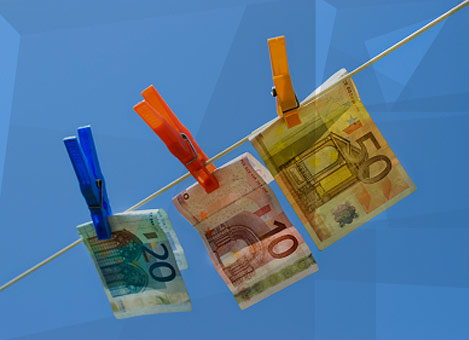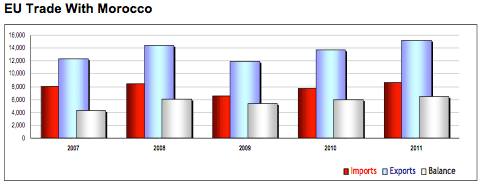ZAWYA
Who’s Exposed To EU?
Morocco, Egypt, Libya and Algeria are at high risk to a Eurozone meltdown, but Gulf states hardly have reason to be complacent, according to new research.
Morocco, Egypt, Libya and Algeria are at high risk to a Eurozone meltdown, but Gulf states hardly have reason to be complacent, according to new research.Although market observers have been crying wolf over the impending Eurozone crisis for more than two years, there is no question that the EU turmoil hangs over the global economy like a dark cloud – an escalation of the crisis or default could have catastrophic results.
None would be more impacted in the region than Morocco, which has been placed at ‘extreme risk’ in Maplecroft’s Eurozone Exposure Index 2012, along with sixteen other countries.
Algeria, Libya and Egypt, which traditionally count the EU as their key trading partner, are considered ‘high risk’ by the risk consultancy.
The International Monetary Fund expects zero growth in the European Union this year and a miserly 1% growth next year, and that’s going to take its toll on its North African trading partners.
“With the IMF predicting GDP growth of just 0.7% in 2013, the outlook for the Eurozone remains precarious and any further slowdown for the region would have the most severe impact on United Kingdom struggling economy,” Maplecroft analysts said in a report. “Moreover, a potential collapse of large euro economies such as Spain or Italy would reduce the UK’s trade by approximately 7% and prompt losses around GBP95-billion (7% of GDP) in Britain’s banking sector.”
The EU crisis could not have come at a worst time for most North African states after they battled political chaos last year.
While Morocco managed a sterling 4.6% growth in GDP despite disruptive regional unrest, it suffered due in the absence of European tourists.
“Tourism seems to be stagnating a little, however, compared with the previous year: there were 9.34 million visitors in 2011, or a mere 1% increase, while overnight stays declined by 6%. This was due to the economic situation in Europe, particularly in France and Spain,” said African Development Bank (AfDB) in its latest report on the country.
Morocco has a free trade agreement with the EU and its trade with the continent accounts for 60% of its total exports.

The EU meltdown would also negatively impact Morocco’s efforts to address its substantial unemployment challenge. The Moroccan authorities believe they need economic growth of more that 6% to absorb the nearly 150,000 Moroccans that enter the job market each year, and trouble up north will mean Morocco may fall way short of that target.
“Morocco faces a structural unemployment problem among young urban graduates,” said AfDB. “Despite a downward trend in the declared national unemployment rate from 11.6% in 2002 to 8.9% in 2011, this rate is still particularly high among 15 to 24 year-olds, whose unemployment rate in 2011 was 17.6% nationally and 31.3% in the urban-unemployed in 2010.”
Tunisia, like Morocco, faces structural unemployment issues and depends significantly on trade with Europe. The economy is expected to post 2.6% growth this year and has been checked by the problems with its biggest trading partner, which accounts for 70% of all its exports.
Libya, which is in the midst of a robust recovery could also fall victim to the crisis. The IMF expects Libya’s GDP to rise an astonishing 116% as oil production comes back on line, led primarily by hydrocarbon GDP which is expected to rise more than 200% this year.
Libya is a key exporter to the European Union and would likely be hurt by further deterioration of the EU’s economic fortunes. OPEC estimates OECD demand to fall by 0.16 million barrels per day next year, primarily due to the decline in OECD Europe.
Egypt, which is focused on soothing political tensions between various stakeholders, also has a high exposure to a potential EU meltdown. Bank of America Merrilly Lynch estimates Egypt will post 1.5% growth this year, compared to the 1.8% posted last year.

In 2011, EU imports from Egypt were dominated by energy (57.9 %), followed by chemicals (10.9%) and textiles and clothes (9.5 %). EU exports to Egypt consisted mainly of machinery (35 %) and chemicals (16.6 %).
GULF STATES AT MEDIUM RISKThe Gulf states are at medium risk to the EU meltdown, but there is hardly room for complacency. Some of the Gulf states’ biggest trading partners, such as the United Kingdom, United States and India are massively exposed to the European Union and could indirectly hurt Gulf exports, particularly hydrocarbons.However, the loss of Iranian crude due to Western sanctions could help Gulf states to increase crude exports even though much of the developing world is also showing signs of a slowdown.”A deflationary external shock has somewhat weaker direct transmission mechanisms in MENA than in other emerging markets given the region’s lower integration with the rest of the world,” says Bank of America Merrill Lynch analyst Turker Hamzaoglu.
“In our view it would take a severe and sustained drop in oil prices to below USD65-70 per barrel for a revision of medium-term spending plans given elevated social pressures in the wake of Arab Spring.”The bank has maintained its growth forecast of 4.3% for the Gulf states but has cut fiscal and current account surpluses to incorporate a cautious view on oil prices. “In the lack of a policy response, our commodities team thinks there could still be downside risk to our revised 2012 oil price forecast (US$109/bbl). As a result, we use a cautious US$105/bbl average oil price for 2012. At these levels, we forecast the GCC fiscal surplus at 10.4% of GDP vs. 13.8% previously. We see limited downside to our real GDP growth numbers at current oil prices, as non-oil sector growth likely remains solid and oil production elevated.”
While the Gulf states may be strong domestically, they could get swept up in the global financial tsunami, especially if other emerging markets also weaken considerably.Maplecroft’s research shows the emerging economies of the BRICS are not immune to Europe’s economic woes. South Africa, Russia, Brazil and India are all classified as high risk countries in the index, while China is rated as medium risk.”The BRICS economies are not fully insulated from the slowdown themselves due to trade and investment relations with Europe and an escalating Eurozone crisis could further exacerbate current domestic slowdown in growth forecasts across the BRICS.
“Investors should follow closely the developments in the Eurozone as the implications will continue to influence global economic behaviour,” states Maplecroft Analyst Daniel Anavitarte. “Trade and investment flows may be disrupted from and to emerging economies while large developed nations could see their growth forecast offset due to their large exposure to euro area banks.”
His words have come on the heels of a variety of action from governments: the ECB and China cut interest rates; the U.S. Federal Reserve extended Operation Twist; the Bank of England announced another round of quantitative easing; and emerging market central banks such as Brazil and Korea cut rates in response to the recent bout of macro weakness.Not everybody is convinced it will work. David Rosenberg, a noted bear and an economist at Gluskin Sheff said these were probably Mr. Draghi’s famous last words, similar to what Hank Paulson said in 2008: “If you have a bazooka in your pocket and people know it, you probably won’t have to use it.” That one didn’t quite work out the way Mr. Paulson intended.”While such actions help reduce immediate financial market stress, core solvency issues among sovereigns and banks have only amplified the recession in Europe,” notes BAML analysts. “Overall, we are not as optimistic as equity markets that policymakers can reverse the negative macro tide.”
© alifarabia.com 2012






